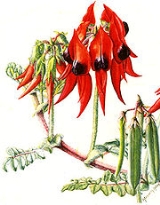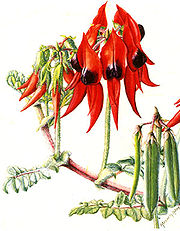
Isaac Swainson
Encyclopedia
Isaac Swainson was the son of John Swainson (d1750), yeoman, of High House, Hawkshead, Lancashire
. He was famous for his botanical garden
, which was largely funded from the profits of a herbal remedy for venereal disease, and a plant genus
is named after him. For his commercial activities in the latter field, he has been called a "radical quack
". He was a relative of William John Swainson, the naturalist.
, where he settled. Later, he purchased from Dr Mercier the recipe of a patent medicine called "Velnos’ Vegetable Syrup", named after Vergery de Velnos. This was one of many cures for venereal diseases based on vegetables rather than mercury
, which is extremely toxic. This brand became well-known and Isaac Swainson reputedly made as much as £5,000 a year from its sales. In addition to curing various venereal diseases, including “the pox” and the “French disease”, it was claimed to cure leprosy
, gout
, scrophula, dropsy, small pox, consumption
, tape worms, cancer
, scurvy
, and diaorrhea
Whether he believed in the efficacy of his remedy or not, he did study the conventional medicine of the era and gained an MD in 1785, although there is no record of his subsequent election to the Royal College of Physicians
. .
He wrote several commercial pamphlets advocating the efficacy of Velno's Vegetable Syrup under titles such as, An account of cures by Velno's vegetable syrup : in disorders deriving their origin or malignity from scorbutic impurities; which occasion obstructions in the lymphatic vessels that also warned purchasers to steer clear of imitations, which were giving the product a bad name.

, London. Swainson took plants and seeds from many parts of the world.
J C Loudon
, a famous contemporary botanist, wrote that
His wife died in 1806, while Swainson died on 7 March 1812 at his house on Frith Street, Soho.
name Swainsona
, the emblem of South Australia
. The species was named for him by the botanist George Don
.
Lancashire
Lancashire is a non-metropolitan county of historic origin in the North West of England. It takes its name from the city of Lancaster, and is sometimes known as the County of Lancaster. Although Lancaster is still considered to be the county town, Lancashire County Council is based in Preston...
. He was famous for his botanical garden
Botanical garden
A botanical garden The terms botanic and botanical, and garden or gardens are used more-or-less interchangeably, although the word botanic is generally reserved for the earlier, more traditional gardens. is a well-tended area displaying a wide range of plants labelled with their botanical names...
, which was largely funded from the profits of a herbal remedy for venereal disease, and a plant genus
Genus
In biology, a genus is a low-level taxonomic rank used in the biological classification of living and fossil organisms, which is an example of definition by genus and differentia...
is named after him. For his commercial activities in the latter field, he has been called a "radical quack
Quackery
Quackery is a derogatory term used to describe the promotion of unproven or fraudulent medical practices. Random House Dictionary describes a "quack" as a "fraudulent or ignorant pretender to medical skill" or "a person who pretends, professionally or publicly, to have skill, knowledge, or...
". He was a relative of William John Swainson, the naturalist.
Velno’s Vegetable Syrup
Isaac moved to London where he served as assistant to a Dr. Mercier in Frith Street, SohoSoho
Soho is an area of the City of Westminster and part of the West End of London. Long established as an entertainment district, for much of the 20th century Soho had a reputation for sex shops as well as night life and film industry. Since the early 1980s, the area has undergone considerable...
, where he settled. Later, he purchased from Dr Mercier the recipe of a patent medicine called "Velnos’ Vegetable Syrup", named after Vergery de Velnos. This was one of many cures for venereal diseases based on vegetables rather than mercury
Mercury (element)
Mercury is a chemical element with the symbol Hg and atomic number 80. It is also known as quicksilver or hydrargyrum...
, which is extremely toxic. This brand became well-known and Isaac Swainson reputedly made as much as £5,000 a year from its sales. In addition to curing various venereal diseases, including “the pox” and the “French disease”, it was claimed to cure leprosy
Leprosy
Leprosy or Hansen's disease is a chronic disease caused by the bacteria Mycobacterium leprae and Mycobacterium lepromatosis. Named after physician Gerhard Armauer Hansen, leprosy is primarily a granulomatous disease of the peripheral nerves and mucosa of the upper respiratory tract; skin lesions...
, gout
Gout
Gout is a medical condition usually characterized by recurrent attacks of acute inflammatory arthritis—a red, tender, hot, swollen joint. The metatarsal-phalangeal joint at the base of the big toe is the most commonly affected . However, it may also present as tophi, kidney stones, or urate...
, scrophula, dropsy, small pox, consumption
Tuberculosis
Tuberculosis, MTB, or TB is a common, and in many cases lethal, infectious disease caused by various strains of mycobacteria, usually Mycobacterium tuberculosis. Tuberculosis usually attacks the lungs but can also affect other parts of the body...
, tape worms, cancer
Cancer
Cancer , known medically as a malignant neoplasm, is a large group of different diseases, all involving unregulated cell growth. In cancer, cells divide and grow uncontrollably, forming malignant tumors, and invade nearby parts of the body. The cancer may also spread to more distant parts of the...
, scurvy
Scurvy
Scurvy is a disease resulting from a deficiency of vitamin C, which is required for the synthesis of collagen in humans. The chemical name for vitamin C, ascorbic acid, is derived from the Latin name of scurvy, scorbutus, which also provides the adjective scorbutic...
, and diaorrhea
Whether he believed in the efficacy of his remedy or not, he did study the conventional medicine of the era and gained an MD in 1785, although there is no record of his subsequent election to the Royal College of Physicians
Royal College of Physicians
The Royal College of Physicians of London was founded in 1518 as the College of Physicians by royal charter of King Henry VIII in 1518 - the first medical institution in England to receive a royal charter...
. .
He wrote several commercial pamphlets advocating the efficacy of Velno's Vegetable Syrup under titles such as, An account of cures by Velno's vegetable syrup : in disorders deriving their origin or malignity from scorbutic impurities; which occasion obstructions in the lymphatic vessels that also warned purchasers to steer clear of imitations, which were giving the product a bad name.

The Botanical Garden at Twickenham
His profits from his patent medicine left him with sufficient money to take a sizeable estate and operate a botanical garden, which became quite noted in its time. It was located in the Heath Lane Lodge estate in TwickenhamTwickenham
Twickenham is a large suburban town southwest of central London. It is the administrative headquarters of the London Borough of Richmond upon Thames and one of the locally important district centres identified in the London Plan...
, London. Swainson took plants and seeds from many parts of the world.
J C Loudon
John Claudius Loudon
John Claudius Loudon was a Scottish botanist, garden and cemetery designer, author and garden magazine editor.-Background:...
, a famous contemporary botanist, wrote that
It contained every tree and shrub that could be procured at the time in British nurseries, and was kept in the first style of order and neatness.
His wife died in 1806, while Swainson died on 7 March 1812 at his house on Frith Street, Soho.
Sturt's Desert Pea
It is Isaac Swainson, not William Swainson who was less noted for botany, who is honoured in the genusGenus
In biology, a genus is a low-level taxonomic rank used in the biological classification of living and fossil organisms, which is an example of definition by genus and differentia...
name Swainsona
Swainsona
Swainsona is a large genus of flowering plants native to Australasia. There are 85 species, all but one of which is endemic to Australia; the exception, S...
, the emblem of South Australia
South Australia
South Australia is a state of Australia in the southern central part of the country. It covers some of the most arid parts of the continent; with a total land area of , it is the fourth largest of Australia's six states and two territories.South Australia shares borders with all of the mainland...
. The species was named for him by the botanist George Don
George Don
George Don was a Scottish botanist.George Don was born at Doo Hillock, Forfar, Angus, Scotland on 29 April 1797. His father, also named George Don, was Superintendent of the Royal Botanic Garden Edinburgh in 1802 and his mother was Caroline Clementina Stuart. George was the elder brother of David...
.

